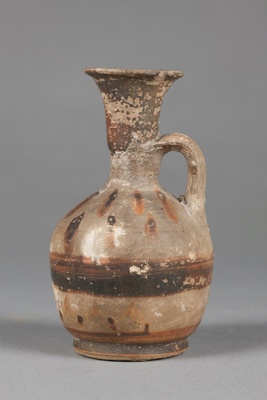< Collection search
< Collection highlights
From:UC Teece Museum of Classical Antiquities
Name/TitleSquat Lekythos
About this objectLekythoi (the plural of lekythos) are Greek vessels commonly used for storing oils, often olive oil. A squat lekythos is notable for its rounded belly and its small size, rarely being larger than 20cm tall.
This squat lekythos is a bit of a mystery. It is possibly from Boeotia, in central Greece, but the centre of manufacture is currently unknown. It appears to have been made in the early 4th Century BCE. The potting, particularly the treatment of the mouth and underside, suggest this period is likely. The lip is slightly convex with a sharp inner edge. The neck transitions smoothly into the body with a sloping shoulder. On the underside there is a concave moulding from the resting surface to the underside of the floor.
The reddish-buff clay has been fired to a pale cream-buff colour at the surface. Brown paint has been used for decoration around the neck and body, and the mouth has been painted solid inside and out. A brown band runs down the outer face of the handle. The decoration has been added hastily, shown in the rough vertical strokes on the shoulder, and especially on the lower wall where the roughly drawn zigzag retains obvious accumulations of paint at the bottom of the strokes.
Date Madeca. 400-360 BCE
PeriodHellenistic
Place NotesPossibly made in Boeotia
Medium and MaterialsPottery: Ceramic
TechniqueThrowing (pottery technique)
TechniqueGlazing (coating process)
MeasurementsHeight 100mm; Diameter 58mm
Subject and Association KeywordsFood history
Named CollectionThe James Logie Memorial Collection, University of Canterbury, New Zealand
Credit LineDonated by Mrs Broadhead, 1968. From the collection of Professor H.D. Broadhead.
Object TypeContainers
Object number80.68
Copyright LicenceAll rights reserved
